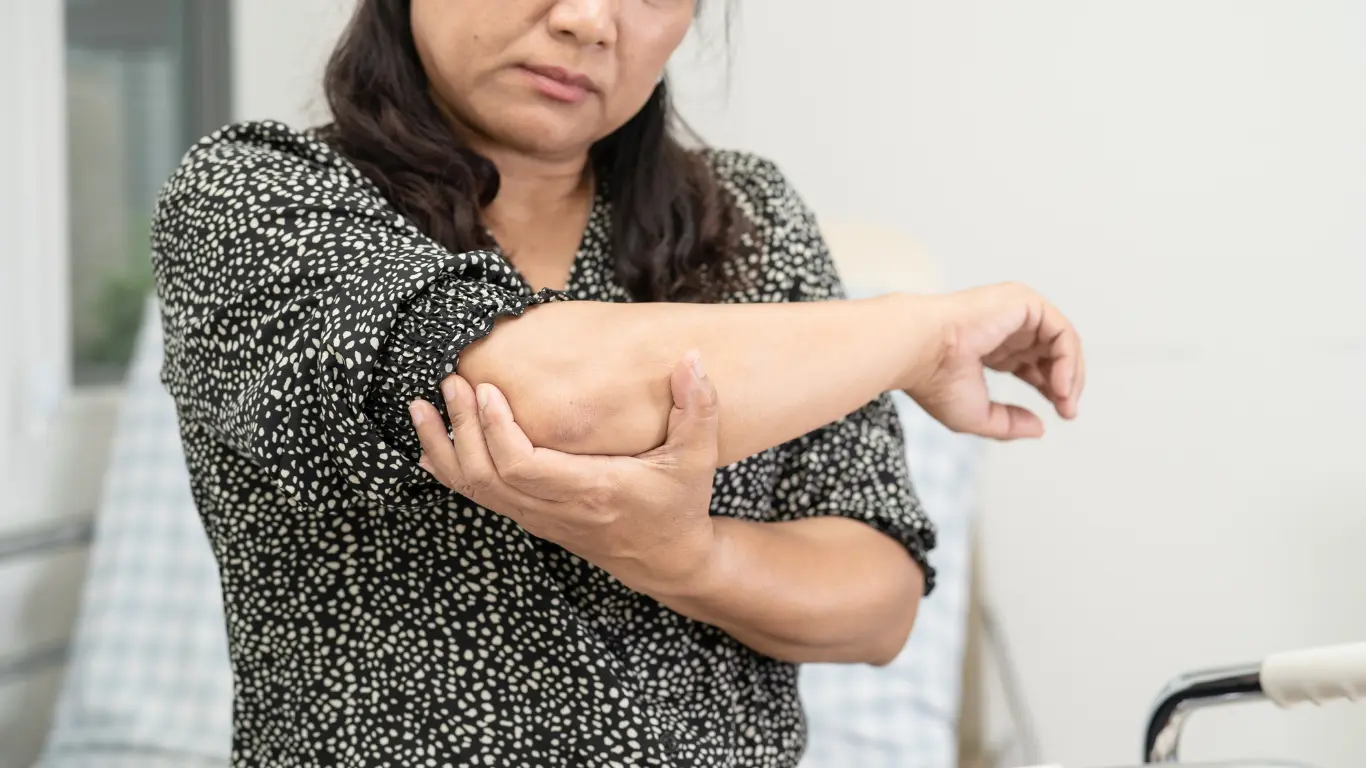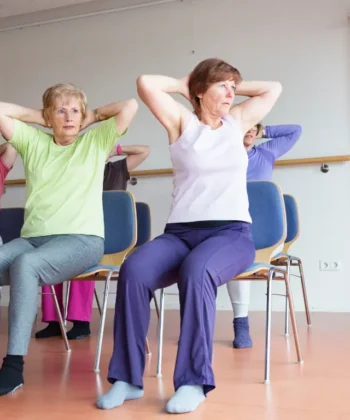
Table of Contents
If your elbow feels sore, won’t straighten properly, or you suspect a hyperextended elbow, you’re not alone, many people go through the same thing.
You might be wondering, “Did I sleep weird? Did I injure it?”
Or worse, “Is this serious?”
That’s the same confusion a lot of people feel before they find out their elbow’s actually bent back a bit too far. When the joint bends a little too far backward, it often happens without even noticing it at first.
The good part? You can heal, and often, all it takes is some rest, care, and listening to your body.
In this blog, I’ll walk you through what a hyperextended elbow actually is, how to recognize the symptoms, what treatments truly help, and how long recovery can take, all in a simple, calm way.
Whether you hurt it during a workout or a fall, or you’re just unsure what’s going on, this guide is here to help you feel informed and supported.
What Is a Hyperextended Elbow?
Your elbow is designed to bend and straighten within a certain range, not too far forward, and definitely not too far backward.
But sometimes, whether from a fall, a sudden jolt during exercise, or even stretching too hard in yoga, the joint goes past its natural limit.
That’s what we call a hyperextended elbow.
It happens when your elbow bends backward beyond its normal range of motion, causing stress or damage to the ligaments, tendons, or soft tissue around the joint. A lot of people don’t notice it right away, mild stiffness, clicking, or a subtle pain when trying to straighten your arm.
Hyperextended Elbow in Children
Kids are naturally bendy, but if your child says their elbow hurts, won’t straighten, or looks slightly bent backward, they may have hyperextended it while playing or falling.
Always watch for swelling, unusual movement, or pain, and don’t hesitate to check with a doctor, especially if they can’t move their arm without discomfort.
Hyperextended Elbow vs. Normal Elbow
- Normal Elbow: Straightens without pain, stops at a certain angle
- Hyperextended Elbow: Bends past that natural stop point, may feel loose, unstable, or painful
What Are the Symptoms of a Hyperextended Elbow?

Elbow hyperextension doesn’t feel the same for everyone. For some, it’s just a nagging soreness; for others, it can be sharp and really limit movement. Sometimes the pain is instant (like after a fall), and sometimes it creeps in slowly, especially after a workout or a strong stretch.
According to a medically reviewed article by Dr. William Morrison, M.D., on Medical News Today, common symptoms of a hyperextended elbow include swelling, stiffness, pain while touching or moving the elbow, and even a popping sound at the time of injury. These signs help differentiate it from other conditions like tennis elbow. In more severe cases, there may be muscle spasms, reduced arm strength, or visible deformity — all indicators that medical attention is needed.
Here are the most common hyperextended elbow symptoms to look for:
1. You Can’t Straighten Your Elbow Fully
This is one of the first signs people notice.
You try to stretch your arm out, but it stops short, feels stiff, or sends a pulling pain behind the joint. You might think, “I must’ve slept weird,” but it could be a hyperextension injury
2. Pain Behind the Elbow
The pain is usually centered at the back of your elbow and may feel worse when you try to straighten or put pressure on it. If the pain increases after activity (like yoga, push-ups, or lifting), that’s a red flag.
3. Swollen or Puffy Elbow
A swollen elbow can mean the tissues or ligaments are inflamed.
You might notice it looks a bit bigger than the other arm, warm to the touch, or feels tender when pressed. That’s your body’s gentle nudge to slow down and give it some love.
4. Loose or Wobbly Feeling (Especially in Kids)
In children with a hyperextended elbow, the joint may feel unstable, like it could bend too far without control.
If your kid is avoiding movement or says their elbow hurts, it’s a good idea to get it looked at, better safe than sorry.
Other Possible Symptoms:
- Tingling or numbness in the hand (in rare cases)
- Weak grip strength
- A soft “pop” sound at the time of injury
- Bruising or discoloration around the elbow
Note: Not all elbow pain is caused by hyperextension, but if you’re experiencing elbow pain after a workout, can’t fully straighten your arm, and see swelling or stiffness, it’s a good idea to treat it gently or consult a professional.
How to Treat a Hyperextended Elbow at Home

If you’ve realized your elbow might be hyperextended, don’t panic; in most cases, it can be treated safely and gently at home. Whether it happened during a workout, a fall, or even while stretching, your body can heal; it just needs rest and the right kind of care.
Here’s how to treat a hyperextended elbow naturally and at home:
1. Rest Is Your First Treatment
This isn’t the time to “push through the pain.”
Give your elbow a break from lifting, workouts, or anything that puts pressure on the joint. Rest helps the ligaments and tissues repair themselves naturally.
2. Apply Ice (Especially in the First 48 Hours)
Use an ice pack or cold compress for 15–20 minutes, a few times a day. It helps reduce swelling, pain, and inflammation. Just make sure to wrap the ice in a cloth never place it directly on your skin.
3. Try Gentle Compression
Wearing a soft elbow brace for hyperextension or using an elastic bandage can support the joint and keep it from overbending. Just don’t wrap it too tight — you want support, not restriction.
4. Natural Inflammation Support
If you’re looking for natural healing, simple kitchen remedies like turmeric tea, ginger compresses, or Epsom salt soaks can help reduce swelling and supplements like magnesium glycinate for muscle relaxation can also support healing and ease muscle tension. These are time-tested ingredients used in Ayurvedic healing.
5. Gentle Movements (After Swelling Goes Down)
Once the pain reduces, you can slowly begin mobility exercises, like gentle elbow bends and wrist rolls. You may also explore mindful movement approaches like somatic pilates to reconnect with your body during recovery to avoid stiffness. But skip this step if the joint is still swollen or painful.
6. Track Your Recovery
For mild injuries, recovery usually takes 1–3 weeks, while moderate hyperextensions might take longer (up to 6–8 weeks).
If things don’t improve after 2 weeks, or pain increases, it’s best to check with a physiotherapist or doctor.
When NOT to Self-Treat:
- Your elbow looks deformed or bent oddly
- You hear a loud pop or feel a sudden sharp pain
- You can’t move your fingers or wrist
- Swelling worsens after 3–4 days
These may be signs of a more serious injury, like a dislocation or ligament tear.
How long does a hyperextended elbow take to heal?

The recovery time for a hyperextended elbow depends on how mild or severe the injury is. For some, it’s just a few days of soreness. For others, healing can take several weeks, especially if the joint was overstretched or the ligaments were slightly torn.
Here’s a general idea of what to expect:
Mild Hyperextension (No Swelling, Minor Pain)
- Recovery time: 5 to 10 days
- Gentle rest, ice, and elbow support are usually enough
- You may feel better in just a few days, but avoid pushing too soon
Moderate Hyperextension (Swelling, Ongoing Pain, Limited Movement)
- Recovery time: 2 to 6 weeks
- You may need a brace, regular icing, and limited use of the arm
- Light physical therapy or stretching may be recommended once swelling subsides
Severe Hyperextension (Sharp Pain, Loud Pop, Bruising, or Instability)
- Recovery time: 6 to 12 weeks (or more if ligaments are torn)
- May require medical attention, physical therapy, or even imaging to rule out joint damage
Important: No matter the severity, avoid rushing your recovery.
Just because the pain eases doesn’t mean everything inside is healed, tissues take time to rebuild. Especially if you’re active or doing yoga, lifting, or typing regularly.
Should I Wear a Brace for a Hyperextended Elbow?
In most cases, yes, wearing a brace for a hyperextended elbow can help support healing, especially during the first few days after the injury. It keeps your elbow from bending too far and gives the strained tissues time to rest.
When a Brace Is Helpful:
- You just injured your elbow and want to prevent further damage
- Your elbow feels unstable, wobbly, or weak
- You’re doing daily activities (like typing, cooking, or lifting light things) and want extra support
- You’re in early recovery and want to avoid accidental overextension
Wearing a soft elbow brace or compression sleeve can reduce movement just enough to protect the joint while still allowing blood flow and healing.
When a Brace Might Not Be Needed:
- Your pain is very mild, and you can move your elbow comfortably
- You’re in the late stage of healing and ready to rebuild strength
- You feel stiffness, in that case, you may need gentle movement more than restriction
Important: A brace is a short-term support, not a long-term solution.
Wearing it too long can make the joint stiff or weak.
So once the pain improves, it’s important to gradually return to gentle movement and, later, strengthening exercises (like the ones we shared above).
How to sleep comfortably with a hyperextended elbow?
Sleeping with a hyperextended elbow can be tricky, especially early in recovery. You find a position that feels okay… then five minutes later, it aches again.
If you’re dealing with a hyperextended elbow, the way you sleep can either help healing or accidentally make things worse (like bending it backward in your sleep).
Here are a few ways to support your arm and sleep better:
1. Sleep on Your Back (If Possible)
This is the most elbow-friendly sleeping position, especially during early recovery.
Place a soft pillow under your arm to keep it slightly bent and supported, not hanging off the side or locked straight.
Pro tip: Use a rolled towel under your elbow crease for gentle support.
2. Avoid Sleeping on the Injured Side
If you sleep on the side where your elbow is hurting, you may unknowingly bend, press, or overextend it during the night. This can lead to stiffness or swelling in the morning.
3. Use a Soft Elbow Brace at Night
Wearing a light, flexible elbow brace while sleeping can help prevent overextension and protect the joint from accidental movements.
Make sure it’s snug but not cutting off circulation — comfort is key.
4. Keep Your Arm Elevated (Optional)
If your elbow is still swollen or warm to the touch, try propping your arm slightly on a pillow to reduce inflammation.
Just don’t overdo elevation — the goal is comfort, not stiffness.
5. Create a Calm Sleep Environment
Elbow pain can feel worse when your mind is tired or anxious.
Consider light stretching, deep breathing, or even a calming herbal tea (like chamomile or turmeric milk) before bed to relax your body and reduce muscle tension.
Avoid:
- Sleeping with your arm hanging off the bed
- Curling up tightly with your arm under your pillow
- Wearing a rigid or bulky brace overnight unless medically recommended
Your body does most of its healing while you sleep.
So be gentle with it — and patient with yourself.
Even if some nights feel uncomfortable, every little tweak you make, even how you sleep, brings you a step closer to healing.
Expert Tip
Most hyperextended elbows heal without surgery, but a physical exam and imaging may be needed to rule out ligament damage or bone injury,” says Dr. William Morrison, M.D., via Medical News Today.
FAQs
Q1. How do I know if I have a hyperextended elbow?
A: If your elbow feels sore, you can’t fully straighten it, or it bends slightly backward and feels unstable, it may be hyperextended.
You might also notice swelling, stiffness, or pain behind the joint — especially after a workout, fall, or stretch.
Try this gentle elbow hyperextension test: straighten your arm and observe if the elbow bends backward more than usual or feels painful when locking out.
Q2. Can you move a hyperextended elbow?
A: Yes, in most mild cases you can still move your elbow, but it may feel tight, weak, or painful. It’s important not to force full range of motion too soon. Let it rest and heal.
Q3. Does a hyperextended elbow heal on its own?
A: Many mild to moderate hyperextensions can heal naturally with rest, ice, gentle support, and patience.
However, if your elbow still hurts after 2 weeks, feels unstable, or shows swelling that isn’t improving, it’s best to consult a doctor or physiotherapist.
Q4. How long does a hyperextended elbow take to heal?
A: Recovery time depends on the severity:
- Mild: 5–10 days
- Moderate: 2–6 weeks
- Severe: 6–12 weeks (may require therapy or medical care)
Q5. Should I wear a brace for a hyperextended elbow?
A: A soft elbow brace can help in early recovery to prevent further bending and provide support.
Avoid wearing it 24/7 — remove it at night unless recommended, and start gentle movement once pain decreases.
Q6. What if I was born with hyperextended elbows?
A: Some people are naturally hypermobile and have joints that extend beyond the normal range.
This isn’t always a problem — but if you experience pain, weakness, or frequent injuries, gentle strengthening and stability exercises can help.
Q7. My elbow still hurts after 2 weeks. What should I do?
A: Ongoing pain after 2 weeks may mean the injury is more than just a mild strain.
It might be more than just a sprain — sometimes it’s a deeper strain or joint issue that needs real attention. It’s smart to get a professional opinion to avoid long-term damage.
Q8. What’s the best elbow brace for a hyperextended elbow?
A: Look for a hinged elbow brace or a functional support brace that prevents backward movement while allowing normal motion.
Top options people use include:
- Push Med Elbow Brace
- Breg Functional Elbow Brace
- Compression sleeves for mild support
Q9. Are hyperextended elbows common in gymnastics?
A: Yes. Gymnasts often develop hyperextension injuries from repetitive impact on straight arms (like handstands or vaults).
A supportive elbow hyperextension brace for gymnastics can help protect the joint during training.
Q10. What exercises help with hyperextended elbow recovery?
A: Once pain and swelling go down, gentle exercises like:
- Elbow bends
- Wrist rolls
- Forearm rotations
- Wall-assisted stretches
…can help rebuild strength and mobility. Avoid anything that causes sharp pain or forces full extension early on.
Q11. Is elbow hypermobility the same as hyperextension?
A: Not exactly.
Hypermobility is when your joints naturally move beyond the normal range.
Hyperextension is when the joint is pushed beyond its limit due to an injury.
People with hypermobility are more likely to experience hyperextension injuries.
Also Read: 5 Erector Spinae Exercises to Strengthen Your Lower Back at Home
Also Read: 12 Basic Yoga Poses for Beginners (PDF, Steps & Pictures)
Also Read: Ayurvedic Remedies for Varicose Veins: 4 Natural Ways




